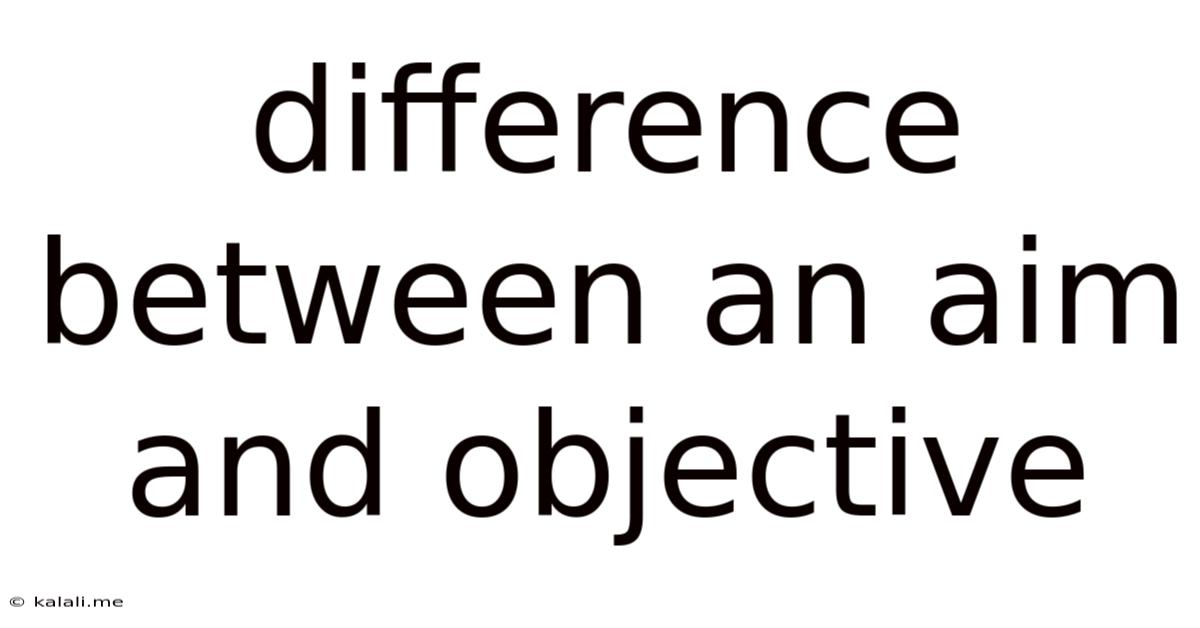Difference Between An Aim And Objective
Kalali
Jun 11, 2025 · 3 min read

Table of Contents
Aim vs. Objective: What's the Difference? A Practical Guide
Meta Description: Confused about the difference between aims and objectives? This guide clarifies the distinction, providing practical examples and helping you set SMART goals for your projects. Learn how to effectively use aims and objectives to achieve your desired outcomes.
Setting goals is crucial for success, whether you're planning a personal project, managing a business, or leading a team. However, many people confuse aims and objectives, hindering their ability to create effective strategies. This article will clarify the difference between these two critical elements of goal-setting and show you how to use them to maximize your chances of success.
Understanding Aims: The Big Picture
An aim is a broad, long-term goal that describes the general direction you want to achieve. It's a statement of intent, often aspirational and qualitative in nature. Think of it as the overall vision or purpose. Aims are usually less specific and measurable compared to objectives.
-
Characteristics of an Aim:
- Broad and general: It sets a general direction without specifying the exact steps.
- Long-term: It's usually achieved over an extended period.
- Qualitative: It focuses on the overall desired outcome rather than specific, measurable results.
- Inspirational: It provides a sense of purpose and direction.
-
Example: "To improve the company's overall market share." This aim is broad; it doesn't specify how much market share to gain or by when.
Understanding Objectives: The Specific Steps
An objective is a specific, short-term, and measurable step that contributes to achieving your aim. Objectives are the concrete actions you'll take to reach your aim. They are the building blocks of your plan, making your aim achievable.
-
Characteristics of an Objective:
- Specific and measurable: It clearly defines what needs to be done and how success will be measured.
- Short-term: It has a defined timeframe for completion.
- Achievable: It's realistic and within your capabilities.
- Relevant: It directly contributes to the overall aim.
- Time-bound: It has a clear deadline. (SMART goals)
-
Example: "To increase market share by 15% within the next quarter by launching a new marketing campaign." This objective is specific, measurable, achievable, relevant, and time-bound (SMART).
The Relationship Between Aims and Objectives
Aims and objectives work together. Your aim provides the overarching direction, while your objectives lay out the specific steps required to reach it. Without specific objectives, an aim remains just a wishful thought. Without a clear aim, objectives might be unproductive or misaligned.
Practical Examples:
Let's consider a personal example:
Aim: To improve my fitness level.
Objectives:
- Objective 1: To run a 5k race in under 30 minutes within three months.
- Objective 2: To attend fitness classes three times a week for the next six months.
- Objective 3: To lose 10 pounds by following a healthy diet and exercise plan within six months.
Conclusion: Achieving Success Through Clear Goal Setting
Understanding the difference between aims and objectives is fundamental to effective planning and goal achievement. By setting clear aims and breaking them down into specific, measurable objectives, you can create a roadmap for success, ensuring your efforts are focused and your progress is easily tracked. Remember to utilize the SMART framework when defining your objectives for optimal results. This clarity will not only enhance your productivity but also significantly increase your likelihood of realizing your aspirations.
Latest Posts
Latest Posts
-
How Many 9s Are In A Deck Of Cards
Jul 01, 2025
-
How Many Pounds Are In 2 5 Kg
Jul 01, 2025
-
Which Is Greater 2 3 Or 2 4
Jul 01, 2025
-
How Do You Pass Level 7 On Bloxorz
Jul 01, 2025
-
If Your 13 What Year Were You Born
Jul 01, 2025
Related Post
Thank you for visiting our website which covers about Difference Between An Aim And Objective . We hope the information provided has been useful to you. Feel free to contact us if you have any questions or need further assistance. See you next time and don't miss to bookmark.